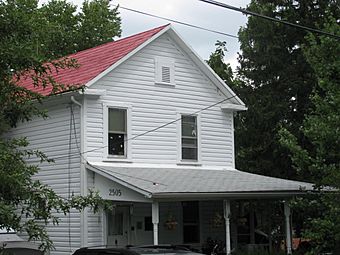Charles Richard Drew House facts for kids
|
Charles Richard Drew House
|
|

Charles Richard Drew House, September 2012
|
|
| Location | 2505 1st Street, South Arlington, Virginia |
|---|---|
| NRHP reference No. | 76002095 |
Quick facts for kids Significant dates |
|
| Added to NRHP | May 11, 1976 |
| Designated NHL | May 11, 1976 |
The Charles Richard Drew House is a special historic home located at 2505 1st Street in Arlington, Virginia. This house is important because it was the home of Charles Richard Drew from 1920 to 1939. Dr. Drew (1904–1950) was a brilliant African-American doctor. His amazing work on how to store blood plasma helped save countless lives during World War II. In 1976, the National Park Service recognized the house as a National Historic Landmark.
Contents
About the Drew House
The Drew House is in a quiet neighborhood in central Arlington. It is a two-story house made of wood. The outside is covered with wood clapboards, and it has a gabled roof. When Dr. Drew owned the house, it was expanded. Two more rooms were added, making it bigger.
Inside the House
The house is designed with a staircase on one side, which is also where you enter. On the first floor, you would find the living room, dining room, and kitchen. Upstairs, there were two bedrooms and a den. It was a comfortable family home for Dr. Drew and his family.
Who Was Charles Richard Drew?
Charles Richard Drew was a very important doctor and scientist. He lived in this house from 1920 to 1939. He went to Amherst College and McGill University for his education. Dr. Drew focused his research on blood transfusions. He was especially interested in how to store blood. At the time, blood would spoil quickly after being taken from a donor.
Drew's Big Discovery
By the time World War II began, Dr. Drew had made a huge breakthrough. He showed that blood plasma could be stored for a very long time. This was possible if it was kept under the right conditions. This discovery was incredibly important for helping wounded soldiers.
Helping During World War II
Because of his amazing work, Dr. Drew was put in charge of a special program. This program sent blood plasma to Great Britain early in the war. When the United States joined the war, the program continued. Dr. Drew's system helped save many lives on the battlefield.
However, Dr. Drew eventually left the program. He disagreed with rules that separated stored blood based on a person's race. After leaving, he became a leading figure at Howard University. He helped train many new African-American doctors. His work changed medicine and inspired many.




